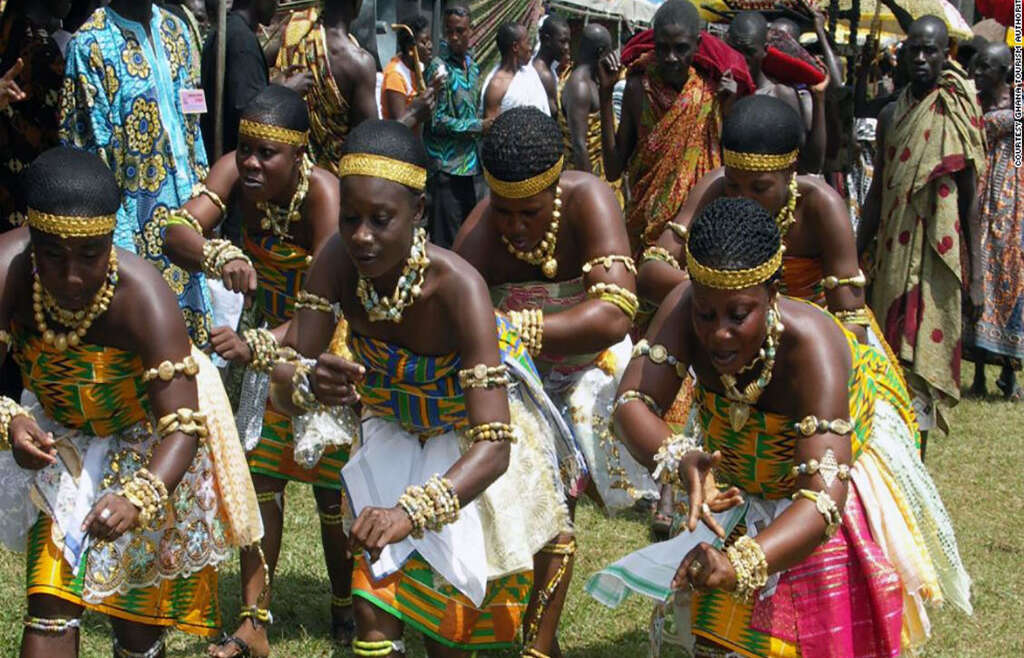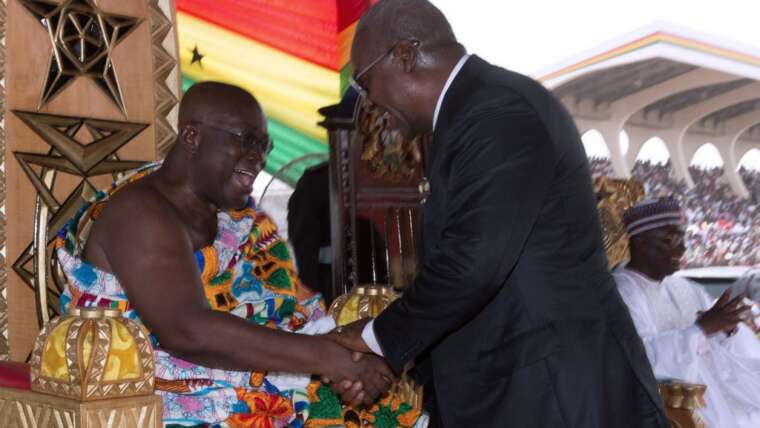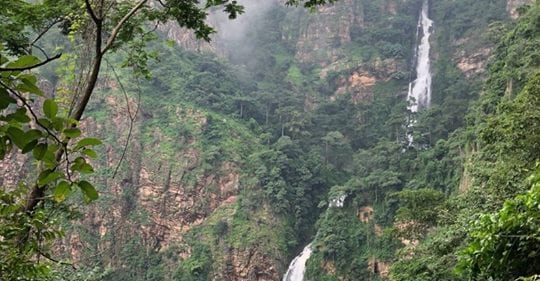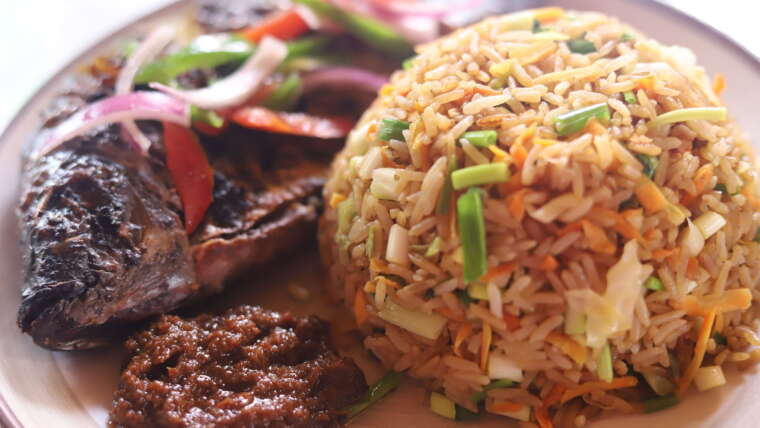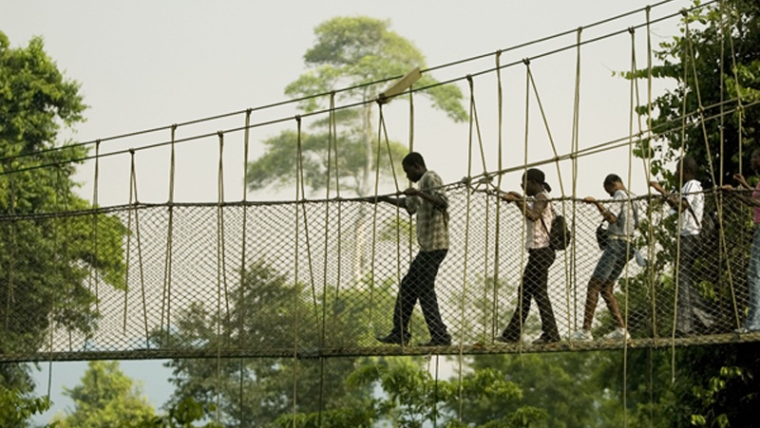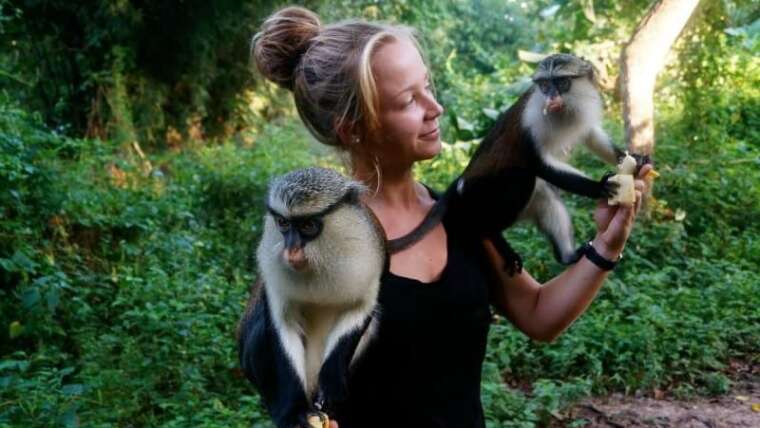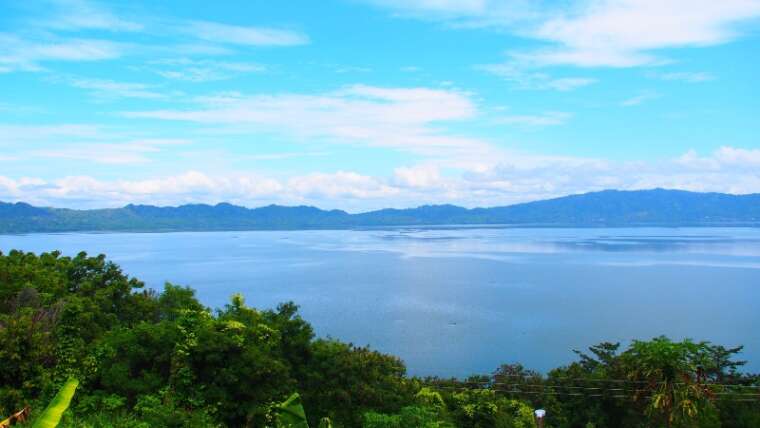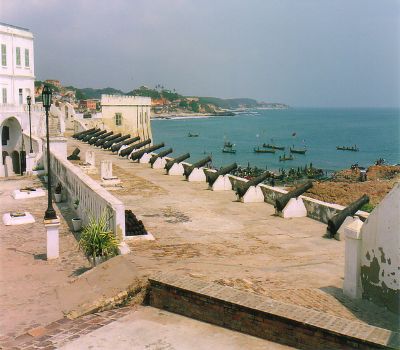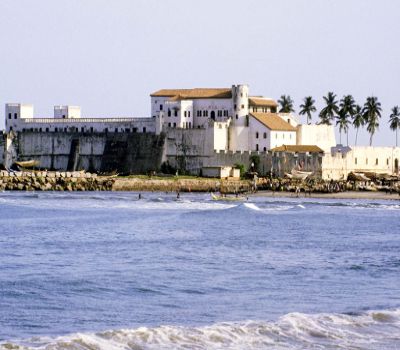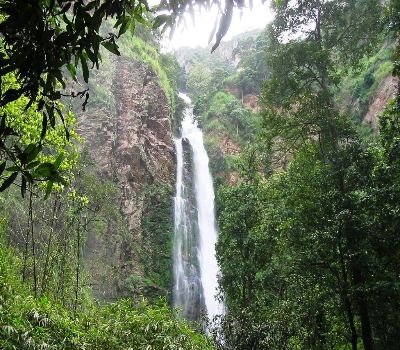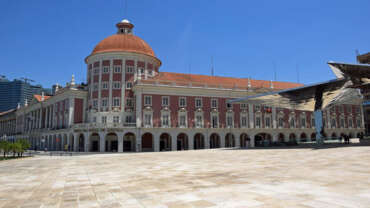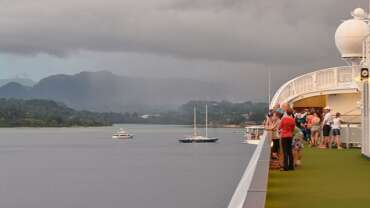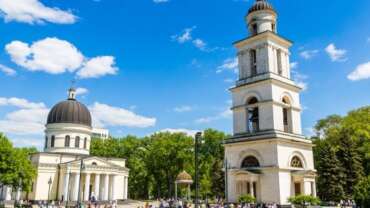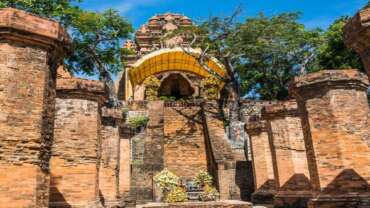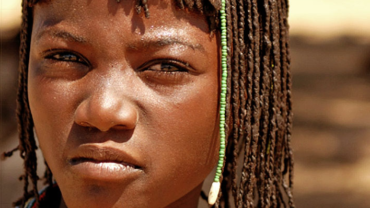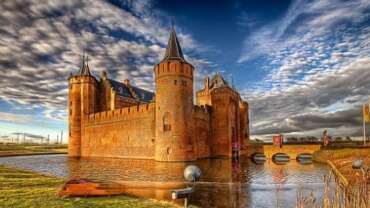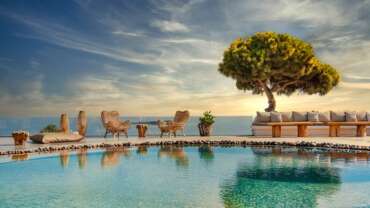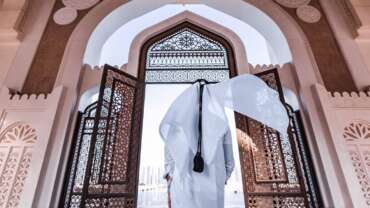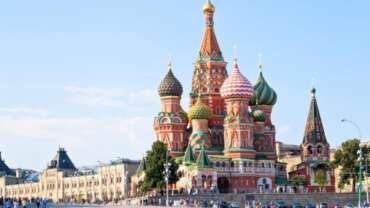AKWAABA
Ghana is situated on the southern coast of the West African bulge and is bordered to the east by Togo, to the west by the Ivory Coast, to the south by the Atlantic Ocean and to the north and northwest by Burkina Faso.
The coastline consists mostly of a low sandy, foreshore behind which stretches the coastal plain, except in the west where the forest comes down to the sea. The forest belt, which extends northward from the western coast and then eastward into Ashanti for about 170 miles, is broken up into heavily wooded hills and steep ridges.
North of the forest is undulating savanna drained by the Black Volta and White Volta rivers, which join and flow south to the sea through a narrow gap in the hills. Ghana’s highest point is 2,9000 feet in a range of hills on the eastern border. Apart from the Volta, only the Pra and the Ankobra rivers permanently pierce the sand dunes, most of the other rivers terminate in brackish lagoons.
About Ghana
The wonderful diversity of natural attractions, historical heritage and the vibrant cultural identity offers visitors of Ghana a microcosmic taste of Africa. Known for the hospitality and friendliness of the people, Ghana is an obvious first port of call for especially first time travelers to the African continent and is a pleasant destination for travelers with children. Ghana is one of the few English speaking countries in the region.
People and culture
Experience rural life and enjoy the friendliness and hospitality of the local people during your visit to one of the many interesting eco-tourism projects in Ghana. Discover the various architectural styles of local houses and the distinctive way of living in the sub-Saharan northern part of the country. Visit the flamboyant festivals celebrated throughout the year and learn about culture and traditions of the various tribes in Ghana. Be amazed by the vibrant parades surrounding the traditional chiefs in their colorful dresses and the rhythmic beat of local drumming.
Visit the traditional weaving villages of Kpotoe, Daboya or Bonwire and explore other craft making villages like the pottery and art village Sirigu and wood carving section of Aburi or Kpando.
Nature
Enjoy the panoramic scenery after climbing to the top of Mount Afadjatoe, Mount Gemi or the Breast Mountains in Kyabobo Natural park; the highest peaks in the Volta Region. Take a refreshing shower under one of the surrounding waterfalls, like the Tagbo falls at Liati Wote, Wli falls or Ote falls.
Spot Mona monkeys living in harmony with the local people in the villages Tafi Atome monkey sanctuary and the Baobeng Fiema monkey sanctuary. Watch elephants, crocodiles and antelopes during a foot safari in Mole National Park. Spot other species of wildlife during an adventurous drive further into the park.
Paddle a pirogue on the Black Volta River and look for hippos. Take a canoe trip at the Amansuri Lagoon and visit the extra-ordinary stilt village Nzulezo. Highly interesting for bird watchers, like the Xavi Bird Watching Sanctuary!
Enjoy the shadow of the giant Baobab trees during your hike through the rock formation around the village Bongo or climb to the sacred caves of Tano. Enjoy the green rolling hills around the banks of the Volta Lake during a two day ferry trip up north.
City life
Go for club hopping in Accra or Kumasi! Browse at Kejetia Market, one of the biggest West African open-air markets, and visit the cultural center and Menhya palace in the Ashanti capital of Kumasi.
Relaxing and beach life
Taking respite from the Ghanaian heat and relax along the exotic beaches around Busua, Elmina or Ada. Relaxation is guaranteed at Ko-Sa Beach Resort, Green Turtle Lodge, Ellis Hideout and others. Enjoy the serene atmosphere and the gorgeous taste of grilled tilapia in the lovely hide-outs at the bank of river or Lake Volta. Relaxation guaranteed at Aloy’s Bay, Xofa village, Rainbow Gardens at Lake Bosumtwi and others.
Sleep in the open-air under a bright sky full of stars! The best places are Sirigu pottery village where you sleep at the flat roof of the decorated compound houses, or Wechiau Community Hippo Sanctuary where you spend the night on a wooden sleeping platform in top of the giant silk cotton tree.
History of Ghana
Ghana was formerly known as the Gold Coast. On 6 March 1957 Kwame Nkrumah declared the country’s independence. On 1 July 1960, Ghana became a commonwealth republic with Nkrumah as the first President of the country. The flag of Ghana consists of the colours red, gold, green, and the black star.
In 1966 its first president and pan-African hero, Kwame Nkrumah, was deposed in a coup, heralding years of mostly-military rule. In 1981 Flight Lieutenant Jerry Rawlings staged his second coup. The country began to move towards economic stability and democracy.
In April 1992 a constitution allowing for a multi-party system was approved in a referendum, ushering in a period of democracy. A well-administered country by regional standards, Ghana is often seen as a model for political and economic reform in Africa.
Cultural Tourism of Ghana
Manhyia Palace Museum
The Museum is a unique creation in West Africa by the Asante Kingdom, to commemorate their leaders, and to communicate the riches of their history and culture to the world. It is a relatively small Museum but stuffed with history larger and older than its size making a visit to the place a worthy one.
The Museum building is of great historical interest and importance as it also houses the Museum’s exhibits such as royal regalia, photographs, medals, furniture, drums and palanquins which are over two hundred years, a battle dress which dates back to 1900 and many objects of historical significance as well as effigies of all past kings and the current occupant of the Golden Stool.
Visitors to the Museum will be able to view video-presentations explaining Asante history and the richness of its culture, as well as splendid examples of the gold-work for which the Asante are world-famous. These include gold weights, bracelets and pots for gold dust which were removed from the Palace by Lord Baden Powell, founder of the Boy Scouts Movement and a member of the British expeditionary force in Kumasi in 1896. Here too are the life-sized effigies of the Nana Prempeh I, Nana Yaa Akyaa and the legendary Nana Yaa Asantewaa, Queen of Ejisu, who in 1900 led the uprising and last of the seven Asante wars with the British, when the British Governor demanded the surrender to him of Asikadwa (Gold Stool).
Kpetoe Kente Weaving Village
Kpetoe Kente Weaving Village is located near the Togo border, a cluster of villages called Kpetoe has produced kente cloth for generations. It is renowned for high-quality Ewe kente, which is unique in design and often less expensive than that from other regions.
Kpetoe has begun efforts to provide expanded and more structured services for tourists. Meanwhile, visitors can have an interesting time exploring the villages, its weavers and kente shops on their own.
Things to Do
- Visit the local kente weaving centre, a roofed, open-air building where up to 25 weavers work and display their products. Only about half of the weavers – speak English, but all will be happy to show their work and negotiate a sale price.
- Shop for kente in village stores, including Israel Trading Inc. on the main road in the centre of kpetoe. Products include kente strips, joined strips, table runners, hats, accessories and clothing. Ask residents to direct you to Bowman Kente Weaving and Desiadenyo Kente Store, which are located off the main street. Proprietors will expect you to bargain with them to arrive at a purchase price.
- Wander through the adjacent village of Abenyinase, where up to 100 weavers work and sell their cloth outdoors.
Ntonso Adinkra Cloth Village
Ntonso is the homeland of adinkra cloth and the only place in Ghana where traditional adinkra is made locally from scratch. Ntonso is still Ghana’s biggest producer of adinkra, a cloth famed for its symbols and proverbial wisdom. The cloth was originally worn only for funerals in the Ashanti Region and produced mainly in black, brown and red. These days, however, it is made in all colors and used throughout Ghana. Ntonso has a new visitor center and lays on official guided tours. On a walking tour, visitors can engage in the various stages of adinkra production, such as dye preparation, cloth dyeing, adinkra stamping and embroidery of stamped cloth.
Daboya Fugu weaving village
Daboya is the most famous of Ghana’s fugu weaving communities. Like kente, the fabric is hand-woven but the strips are narrower and have stripes, in contrast to the geometric patterns found in kente. Nearly all of the thousands of residents of Daboya are involved in the production of fugu. The village has developed into a fascinating site and residents are eager to share their heritage. Tour the village with a guide to see the production of fugu, from making dyes, dyeing cloth, creating designs, weaving and joining strips to finally sewing. Daboya also offers boat tours and cruises on the White Volta River, which flows beside the village. See some of the area’s birdlife, enjoy a fishing demonstration with a hand-thrown net and visit a beach where salt is harvested, all from a hand-made boat, paddled by villagers.
Bonwire Kente Village
They have been making kente cloth since the 17th century in Adanwomase, the royal weaving village for the Asante king. Around half the population of Adanwomase is involved in the making of kente, with weavers showing great pride in their work and often creating personal designs. Visitors are welcome in Adanwomase, which offers guided tours and a chance to buy your very own piece of kente cloth. The weaving tour includes a visit to the community kente workshop, where guests can try their hand at thread spinning, warping, and weaving, as well as a trip to the village shops to buy kente products and other crafts. The tour continues to the chief’s palace, the traditional healer’s shrine, the oldest house in the area (over 300 years old) and a cocoa farm and finishes up at a forest shrine. Visitors can also choose to go on a culinary tour of local farms, take part in palm wine tapping or learn to cook traditional Ghanaian dishes. An evening of dancing, drumming, and storytelling by a cultural troupe can also be arranged.
Sirigu Traditional Pottery, Art and Architecture
The village of Sirigu is a fascinating example of local women taking action to preserve their art and culture. This village is home to beautiful pottery and basketry, interesting architecture and decorative wall paintings. Faced with the loss of these traditional skills as many young women left the village to find jobs, seven women from Sirigu created SWOPA (Sirigu Women’s Organisation for Pottery and Art), which began training local women in making traditional crafts and marketing their products. SWOPA has now grown to include over 350 women and has opened a visitor centre, gallery, workshop and guesthouse complex where visitors can see and buy functional pottery and baskets.
Heritage Tourism in Ghana
Forts and Castles in Ghana
The castles and forts were built and occupied at different times by traders from Portugal, Spain, Denmark, Sweden, Holland, Germany and Britain. They served the gold trade of European chartered companies. Latterly they played a significant part in the developing slave trade, and therefore in the history of the Americas, and, subsequently, in the 19th century, in the suppression of that trade.
Cape Coast Castle
Cape Coast Castle is the largest of the buildings which contains the legacy of the trans-Atlantic slave trade and is a UNESCO World Heritage Site. Like most ancient fortifications in Ghana, Cape Coast Castle played a significant role in the gold and slave trades. But also, two significant contributions were made here: the arrival of Christianity, and the establishment of the first formal education system through Castle Schools.
A guided tour of the Cape Coast Castle will acquaint you with its many interesting features including Dalzel Tower, the slave dungeons, and the cannons and mortars used in the Castle’s defense. The West African Historical Museum is located inside Cape Coast Castle and contains a growing collection of art and cultural objects, including ceremonial drums, old muskets, shackles from the slave trade and ancient pottery.
Elmina Castle
St George’s Castle, a Unesco heritage site, was built as a trading post by the Portuguese in 1482, and captured by the Dutch in 1637. It was expanded when slaves replaced gold as the major object of commerce, with storerooms converted into dungeons. The informative tour (included in the entry fee) takes you to the grim dungeons, punishment cells, Door of No Return and the turret room where the British imprisoned the Ashanti king, Prempeh I, for four years.
Elmina Castle was the first trading post built on the Gulf of Guinea, so is the oldest European building in existence in suib-Saharan Africa. Elmina is also a picturesque fishing town along Ghana’s coast, not far from Cape Coast. It is home to one of Ghana’s biggest attractions, St George’s Castle. Built by the Portuguese in 1482, it was captured by the Dutch 150 years later and became the headquarters of their West Indies Company for the following 250 years.
Gold exports were soon replaced by slaves and the tours through the dungeons will give you a good idea of how gruesome a trade it was. The Castle houses a small museum and guided tours are available. The stark beauty of the white-washed Castle walls contrast deeply with the dark history of this place.
Fort St Jago lies across the lagoon from the castle, and is worth visiting for the views it offers of the town and Castle.
Kwame Nkrumah Memorial Park
Located in downtown Accra, Ghana is the Kwame Nkrumah Memorial Park and Mausoleum. The Mausoleum is the final resting place of Ghana’s first President and Africanist. The museum hosts rare artefacts relating to Ghana’s independence and tours at the park give visitors in-depth history of the Sub-saharan struggle for independence.
The mausoleum designed by Don Arthur houses the mortal remains of Dr. Kwame Nkrumah and his wife Fathia Nkrumah. It is meant to represent an upside-down sword which in the Akan culture is a symbol of peace. The mausoleum is clad from top to bottom with Italian marble, with a black star at its apex to symbolize unity. The interior of the Mausoleum boasts marble flooring and a mini mastaba looking marble grave marker surrounded by river-washed rocks.
Komfo Anokye Sword Site
Situated on the grounds of the Komfo Anokye Teaching Hospital, Kumasi, is the Komfo Anokye Sword Site which is seminal in Asante history. A 333 year old sword wedged in the rockface is one of the the centre artefacts and legends of the rich history of the Asante nation. The history of the Asante people is eloquently told by the young curator. On a good day you may run into the Asante king who regularly comes to pay his respects at this important and sacred site.
A tour of the site offers one great insight about the beginning of the Ashanti Kingdom. The landmark has been protected for future generations. This site is a historical landmark where the Legendary Okomfo Anokye Sword is cited.
The Sword site is the exact place where the Golden Stool of Asanteman descended unto the laps of King Osei Tutu I, “Opemsuo” the founder of Asante Nation. The site was predicted by Okomfo Anokye to be a healing place for millions of people. Lo and behold, the site happens to be the exact place where the Komfo Anokye Teaching Hospital is situated. One fascinating story about the Sword is that, since it was planted in 1695, countless number of attempts had been made to remove it from the ground but to no avail.
The ‘immovable’ Sword driven into the ground by Okomfo Anokye remains and is the venue of the Okomfo Anokye Teaching Hospital. History has it that the sword was pushed into the ground, almost 300 years ago. It is believed the Okomfo pronounced that no one would be able to remove the sword, and so it has remained in spite of attempts. The Ashanti state, it is believed, would collapse should the sword ever be pulled out of the ground.
Okomfo Anokye
Okomfo Anokye (also known as Kwame Agyei, Kotowbere, or Tsala) was a traditional priest in the Asante Empire. He is known for his participation in the expansion of the Ashanti Empire. There are multiple accounts regarding Okomfo Anokye’s origins.
According to Akuapem tradition, he was son of Ano and Manubea, both from Awukugua in the Nifa Division of the Okere state. His name would originate from an incident: This claim was apparently latter confirmed by Otumfuo Nana Osei Tutu II during his visit at Awukugua in 2014. According to Asante traditions, he was the grandson of a man called Amoa Gyata from Bona-Bom, Adanse. There are also claims that he was the son of Kyei Birie and Dwirawira Kwa, who was an Asenie woman from Adanse-Akrokyere. According to Anlo-Ewe traditions, Okomfo Anokye was from Notsie. His original name was Tsala, and he was the twin brother of Tsali. His name would thus originate from an Asante corruption of “Notsie” i.e “Okomfo of Notsie”. The Ewe mythology that Okomfo Anokye was from Notsie and Asantes called him Okomfo Anokye signifying “Okomfo a ofiri Notsie” (i.e.: Okomfo who comes from Notsie) cannot be reconciled with Asante or indeed Akan naming conventions.
Larabanga Mosque
The Larabanga Mosque is thought to be the oldest mosque in Ghana and West Africa. It is popularly referred to as the ‘Mecca of West Africa’, because of its rich historical and architectural values. The dimensions of the mosque are approximately 8m by 8m. The Larabanga Mosque made it to the World Monuments Fund’s List of 100 Most Endangered Sites.
There is some controversy over when exactly the mosque was built, and who built it. The mosque is thought to date back to 1421. It is believed that an Islamic trader called Ayuba, who was travelling through the area, built the mosque. According to one story, Ayuba slept in the area and had a dream in which he was instructed to build a mosque. When he woke up the next morning, the foundation of the mosque had mysteriously appeared, so he continued with the construction until the mosque was complete.
The mosque is made of mud and stick, in Sudanese style. Right next to the entrance is a large baobab tree, under which Ayuba’s remains are buried. The mosque has four entrances: one each for the village chief, men, women, and the muezzin who leads the call to prayer. The mosque houses a very old Koran which is thought to have been delivered from heaven to an Imam called Bramah, around 1650, after he had prayed hard for a Koran.
The mosque is located in a small predominantly Muslim town, called Larabanga, near Damongo in the Western Gonja District in the Northern Region. Non-Muslims are not allowed to enter the mosque.
Apart from their usual role as Friday prayer grounds, the ancient mosques also serve as places of pilgrimage to the Muslim communities in the country. On eventful days, a lot of faithful worshippers gather at these mosques for prayers and listen to Koranic readings.
Private readings are also organized on request for individuals who have serious problems to solve, or who seek spiritual protection on their ventures. In return for the readings, the Chief Imam normally requests the sacrifice of a cow and other donations for the community.
Bisa Aberwa Museum
The Bisa Aberwa Museum is created to be one of the largest sculptural representations in clay, wood, cement, paintings and photographs of personalities whose sacrifices have shaped African history, both within the continent and the diaspora.
It has about 2,200 artefacts, sculptural pieces and photographs of heroes of the African struggle and the African American Civil Rights Movement as well as other Black personalities in the French, Portuguese and Spanish Caribbean.
Bisa Aberwa Museum houses one of the world’s largest private collections of artefacts, sculpture and audio-visual representations of the African story.
The Bisa Aberwa Museum is the brainchild of Mr Kwaw Ansah, one of Africa’s most respected award-winning filmmakers, founder and first Chief Executive Officer (CEO) of TV Africa Limited, is dedicated to preserving the history of the Black Race, promoting African values and celebrating Pan African heroes.
The specimens on display are about personalities whose sacrifices have helped shape African history, both within the continent and the diaspora.
They capture events within the slave dungeons in Africa, the toils of the Africans on the slave plantations and highlights of the Civil Rights Movement culminating in the election of the first African American as President of the United States of America.
The museum also contains documented stories of distinguished personalities such as Dr Esther Ocloo, Paa Grant, Nana Kobina Nketsia IV, A.S. Blay and Dr Kwame Nkrumah.
Assin Manso Ancestral Slave River Site
Assin Manso Ancestral Slave River Park was one of the largest slave markets for gathering people to sell into slavery during the infamous trans-Atlantic slave trade. It is especially worth seeing as a prelude to viewing Cape Coast slave castle since you will be following the route taken by the ancestors of many African Americans.
It was the final link in the slavery route from northern Ghana and was known to have been the largest slave market for the merchant supplying slaves on the forts and castles on the coast.
Trans – Atlantic slave trade came about when people were needed to work on agricultural and mines since the Europeans are not suitable to the climate and not able to survive the tropical disease during the agricultural and mines work. Trans – Atlantic slave trade because, already manufactured goods (tobacco, spirits, beads, cloths, guns etc.) were taken from Europe to Africa in exchange of human beings. Then the exchanged goods (human beings) are shipped to work on plantations and mines. The merchants then return to Europe with the produce from the slave’s labor plantations (cloths, sugar, tobacco, etc.). The transport of the slaves from Africa to America forms the middle passage of the triangular trade.
Nakore Mosque
The Nakore Mosque is located just outside Wa in the Upper West region also shares similar features with the Larabanga mosque, but unfortunately, little is known of the place. The structure of the mosque is that of the Sudanic style. The Sudanic style, though rectangular, has timber frame structures or pillars supporting the roof. It is characterized by two pyramidal towers (the minaret and the mihrab), and by a number of irregular shaped buttresses, with pinnacles projecting above the parapet which give life to the mosque’s elevations.
Apart from the usual role the mosque serves as Friday prayer grounds, the ancient mosques also serve as places of pilgrimage to the Muslim communities in the country. On eventful days, a lot of faithful worshippers gather at these mosques for prayers and listen to Koranic readings. Private readings are also organized on request for individuals who want divine solutions to serious problems or those who seek spiritual intervention in their ventures. The Chief Imam normally requests the sacrifice of a cow and other donations for the community, in return for the readings the Koran.
Most of the communities of the regions of Northern Ghana are predominantly Muslim communities. Islam, which first entered Africa through Egypt in the 10th Century AD, progressed from Egypt towards the west and the south at the same time as the trans-Saharan slave and gold trade routes. In Ghana, these trade routes were used by Mande warriors, Islamic Traders and Missionaries. Occasionally, these routes were marked by incursions by the Almoravids, a Berber Dynasty, which played a major role in the spread of Islam in the area. At rest points for the Islamic traders along the routes, and in conquered territories people were converted to Islam and this led to the construction of mosques in the Northern part of Ghana. Some of these mosques still exist today and they date as far back as the 17th Century AD. Nicely built with ancient architecture, the Nakore Mosque although sacred to the people of the region also makes a great tourist attraction.
Incase you find yourself in the Upper West region of Ghana on a trip, you can round off your trip by visiting the 16th century Nakore Mosque, a very solemn place to visit and learn much about the Muslim tradition of the people in the region.
AKWAABA
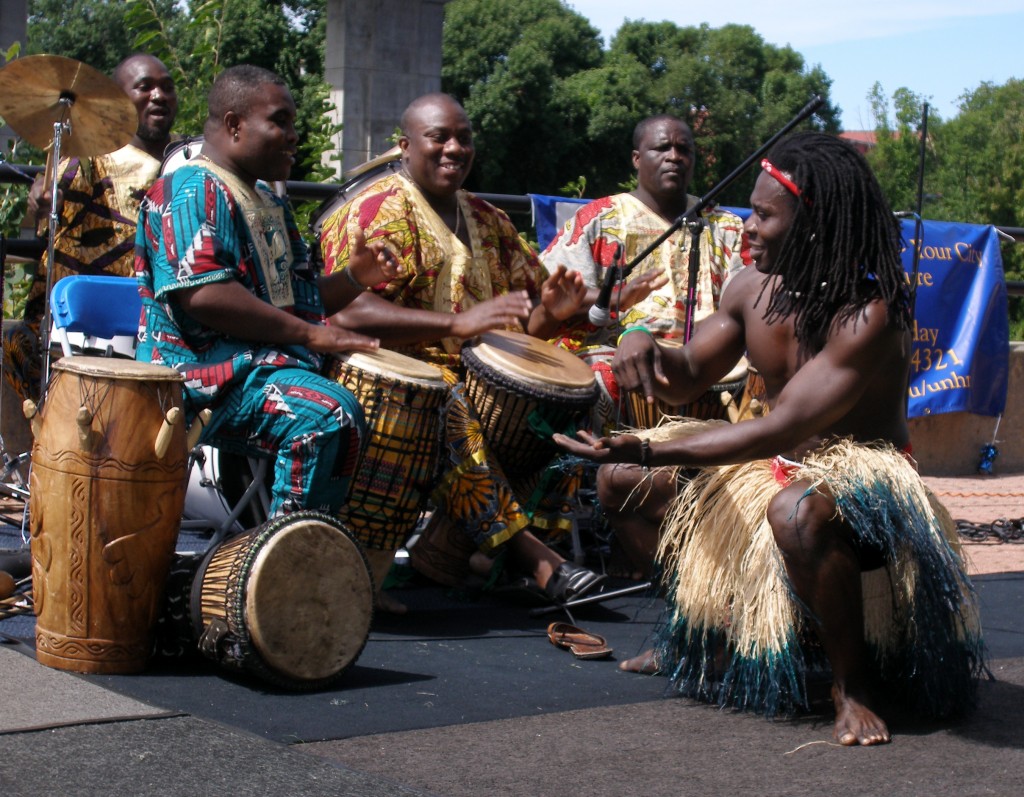
“Theo and the Akwaaba Ensemble gave a performance that warmed up the audience despite a blinding snowstorm in Bethel! Akwaaba gives the audience a unique look into the world of music and dance of Ghana that is both enlightening and energetic” ~ Linda Gamble, Mahoosuc Arts Council, Bethel ME
Energized drumming and dancing blended with Highlife music makes them unique! Theo Nii Martey formed the Akwaaba Traditional African Drum and Dance Ensemble during a tour with Brekete Ensemble in London. It brings together a group of friends who have been drumming and dancing together for many years in Ghana and the UK. The group includes past members of the National Dance Ensemble, Brekete Ensemble and the Shidaa cultural troupe.
The Akwaaba Ensemble’s energetic and engaging performances are a reflection of their name, which means ‘welcome’ in the Twi language of the Ashanti tribe of Ghana. At each performance the Ensemble brings Highlife music, West African drumming and dance to vivid life.
Audiences agree that their performances are “overwhelmingly positive. Once you hear their music, you can’t resist moving”.
Each Ensemble member teaches and leads workshops. Together they have connected with students at dozens of schools around the globe. Parents and teachers praise their work: “These guys are energetic, enthusiastic. They’re really knowledgeable about what they are doing, and they seem to really enjoy working with kids.”



